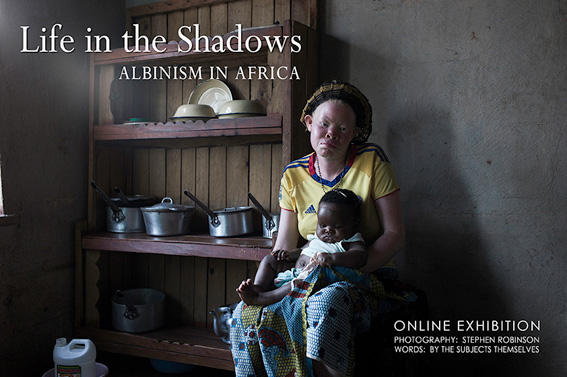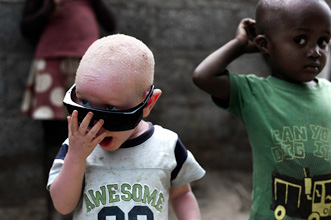 This project came about as a result of the author, Stephen Robinson, occasionally seeing, over many years in Africa, people with albinism walking on the African streets. They were usually alone and under the shade a large umbrella. Who are these people; what are their lives like; how and where do they live?
This project came about as a result of the author, Stephen Robinson, occasionally seeing, over many years in Africa, people with albinism walking on the African streets. They were usually alone and under the shade a large umbrella. Who are these people; what are their lives like; how and where do they live?
The modern-day social issue of living with albinism in Africa is, today, probably much as it has been for centuries - an issue steeped in deep-rooted superstition and mythology. Most media coverage of Africans with albinism is centred on the news-grabbing extremes of their physical abuse, mutilation and even murder. Such coverage makes little mention of the adversities they face every day - including stigma and extreme discrimination, isolation and exclusion, serious health and vision problems, and public ridicule. And all this every day, day-in, day-out.
The Canada-based "Under the Same Sun" organisation campaigns for greater awareness, understanding and action on albinism. It puts the prevalence of albinism in Africa into context as follows: "While numbers vary, in North America and Europe it is estimated that 1 in every 20,000 people have some form of albinism. In Tanzania, and throughout East Africa, albinism is much more prevalent, with estimates of 1 in 1,400 people being affected."
Under the Same Sun's representative Don Sawatzky says: '“If the attacks and killings stopped today, most of the hardships related to albinism, especially on the African continent, would carry on as if nothing had happened. The stigma, discrimination and skin cancer related suffering and deaths that affect the everyday life of a person with albinism, would still be agonizingly difficult for most."
 So this exhibition tells a story about the ordinary: the ordinary daily story of African people with albinism, a story that few of us know about. Accompanying the photographs as part of the exhibition are the subjects’ own stories of their daily lives, in their own words - far more telling than anything the Stephen Robinson could write.
So this exhibition tells a story about the ordinary: the ordinary daily story of African people with albinism, a story that few of us know about. Accompanying the photographs as part of the exhibition are the subjects’ own stories of their daily lives, in their own words - far more telling than anything the Stephen Robinson could write.
Stephen says "The research, investigation and photo work has taken about 6 months so far, mostly full time. First the people had to found and contacted, talked to, and their stories and involvement requested. I had thought I would find a few people with albinism and make a small reportage showing their lives, their homes and families, how they live and the adversities they face. But then it was shocking to discover just how prevalent albinism is in Africa - and how very many people there are hiding away as a result of the persecution and health risks that come with their condition. So the project grew and grew.
I've attempted to do the photography in a reportage style, accompanied by the subjects' own words - to tell their story and hopefully bring attention to what is a major, but tragically ignored, human rights issue. Very few people know about this, and when they are told, they are usually horrified that this exists in this 21st century.
I usually prefer to work in (and think in) black-and-white for people and reportage work, to direct maximum attention to the subject by avoiding the distraction of colour. But here I decided that because this issue is so strongly associated with skin colour, using colour would add rather than distract.
 Of course all serious photography is about light and how it's used, but this is particularly so for the subject matter of this project. The subjects' lives and daily routines are dictated by light and shadow, by being outside or inside, and by conscious decisions about moving from one to the other. As the work progressed, use of the same motifs came about - strong light and deep shadow, doorways, curtains, alley-ways, and the like.
Of course all serious photography is about light and how it's used, but this is particularly so for the subject matter of this project. The subjects' lives and daily routines are dictated by light and shadow, by being outside or inside, and by conscious decisions about moving from one to the other. As the work progressed, use of the same motifs came about - strong light and deep shadow, doorways, curtains, alley-ways, and the like.
This is all available-light photography done at and in the subjects' homes and work places. Waiting to be ignored before making the shots was an important element, as was using only the minimum of equipment - only two lenses 50mm and 35mm were used. Just about all the photographs are uncropped, full frame showing what I saw through the viewfinder. Things are more real that way.
The full exhibition may be seen on Stephen Robinson's Wildfotoafrica.com website.
All images are copyright Stephen Robinson, and reproduced here by kind permission of the author.






